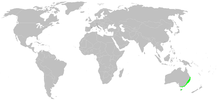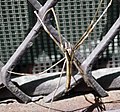| This article includes a list of general references, but it lacks sufficient corresponding inline citations. Please help to improve this article by introducing more precise citations. (February 2019) (Learn how and when to remove this message) |
| Asianopis subrufa | |
|---|---|

| |
| Females are light reddish brown | |
| Scientific classification | |
| Domain: | Eukaryota |
| Kingdom: | Animalia |
| Phylum: | Arthropoda |
| Subphylum: | Chelicerata |
| Class: | Arachnida |
| Order: | Araneae |
| Infraorder: | Araneomorphae |
| Family: | Deinopidae |
| Genus: | Asianopis |
| Species: | A. subrufa |
| Binomial name | |
| Asianopis subrufa (L. Koch, 1878) | |

| |
| Excludes New Zealand | |
| Synonyms | |
| |
Asianopis subrufa (also called the rufous net-casting spider) is a species of net-casting spiders. It occurs in Australia (Queensland, New South Wales, Victoria and Tasmania) and in New Zealand. It is a nocturnal hunter, having excellent eyesight, and hunts using a silken net to capture its prey. They feed on a variety of insects – ants, beetles, crickets and other spiders. They can vary in colour from fawn to pinkish brown or chocolate brown. Females are about 25 mm in body length, males about 22 mm. They are not dangerous to humans.
This species is often found on a few strands of web in forest, woodland and heathland, or on flat surfaces, for example on the outside of houses.
Taxonomy
Asianopis subrufa was first described by Ludwig Koch in 1878, in the genus Deinopis. In 2020, the species was transferred to the newly erected genus Asianopis which contains the Asian and West Pacific species formerly included in the genus Deinopis. The specific epithet subrufa is Latin for "reddish".
Mating
| This section does not cite any sources. Please help improve this section by adding citations to reliable sources. Unsourced material may be challenged and removed. (February 2019) (Learn how and when to remove this message) |
Males will usually shed their last skin and then seek a suitable female to mate with. They will rest on the outer skirts of the female's web, and will gently pluck the web to show her that they are interested. Days after mating, the female then constructs a globular egg sac, approximately 10–12 mm in diameter. It is generally a light brown or fawn colour with black specks on it and contains anywhere from 100 to 200 eggs. It is usually disguised and protected by a leaf. Once the female has constructed the egg sac and laid the eggs, she will usually leave it to its own fate. After around 3 weeks, the young hatch.
Gallery
References
- ^ "Taxon details Asianopis subrufa (L. Koch, 1878)", World Spider Catalog, Natural History Museum Bern, retrieved 15 November 2022
- Lin, Yejie; Shao, Lili; Hänggi, Ambros; Caleb, John T.D.; Koh, Joseph K.H.; Jäger, Peter; Li, Shuqiang (2020). "Asianopis gen. nov., a new genus of the spider family Deinopidae from Asia". ZooKeys (911): 67–99. doi:10.3897/zookeys.911.38761. PMC 7031397. PMID 32104139.
- Olivetti, Olivetti Media Communication-Enrico. "ONLINE LATIN DICTIONARY - Latin - English". online-latin-dictionary.com. Retrieved 2024-11-05.
External links
- Pictures of A. subrufa
- Australian Biological Resources Study
- Australian Museum web site
- Australian Museum web site, Net-casting Spiders
| Taxon identifiers | |
|---|---|
| Asianopis subrufa | |
| Deinopis subrufa | |
This article related to araneomorph spiders is a stub. You can help Misplaced Pages by expanding it. |
